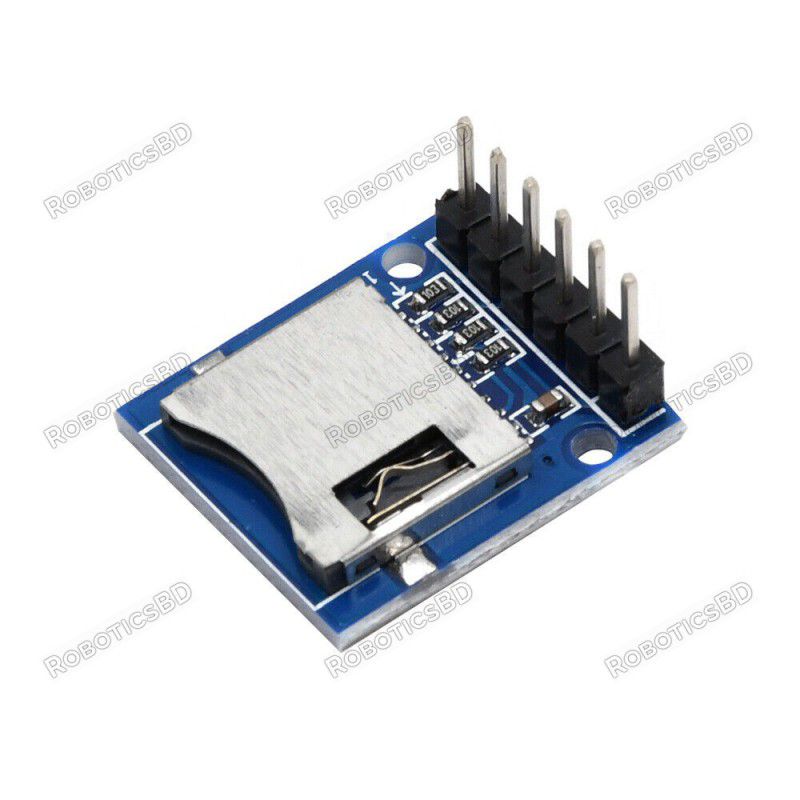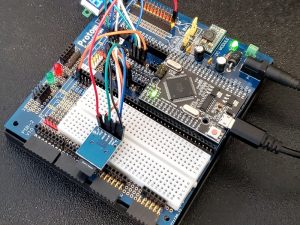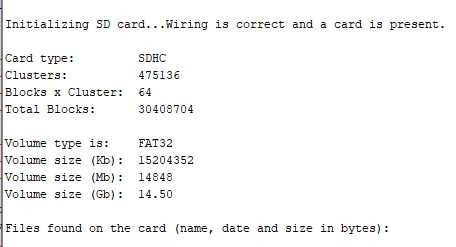
Reference: RBD-1354
Jumper Wire Single 20cm
Length: 8 inches/20 CM (Long) Material: Copper Plated Pin Spacing: 2.54mm.
Reference: RBD-1354
Length: 8 inches/20 CM (Long) Material: Copper Plated Pin Spacing: 2.54mm.
Reference: RBD-0351
Contactless transmission of data and supply energy (no battery needed) Operating distance: Up to 100mm (depending on antenna geometry) RoboticsBD Operating frequency: 13.56MHz Data transfer: 106 kbit/s Data integrity: 16 Bit CRC, parity, bit coding bit counting Anticollision Typical ticketing transaction: <100 ms ( including backup management)...
Reference: 0245
Choose your desire Resistor value from below:
Reference: 0031
3 Types Available (Please select from option) 1. Male to Male 2. Male to Female 3. Female-Female
Reference: RBD-0768
Size: 5mm Color: RED Head Shape: Round Lens Appearance: Transparent
Reference: 1353
Length: 12.5 inches/30 CM (Long) Material: Copper Plated Pin Spacing: 2.54mm.
Reference: RBD-0761
Breadboard friendly Mounting Style: Through Hole Mounting Direction: Vertical


Allows MicroSD cards to be written and read
 Store Pickup Available!
Store Pickup Available!
 Free Ship Over 5000 BDT
Free Ship Over 5000 BDT
 Quality Product
Quality Product
 No Warranty
No Warranty
 No Replacement
No Replacement
This MicroSD card module allows MicroSD cards to be written and read for applications that create or need access to large quantities of data.
SD cards are commonly used for applications such as temperature logging where the time and temperature are recorded over long periods of time. It can also be used to serve large amounts of data such as graphic images.
This MicroSD card module should be thought of as a raw card slot and operates at 3.3V which is the voltage the MicroSD card operates at. The data lines must be at 3.3V logic levels to prevent damage to the MicroSD card and so this module is best used with 3.3V MCUs. If used with a 5V MCU, external logic level shifters are required for the SPI bus lines to avoid damage.
The data lines have 10K pull-up resistors to 3.3V on the module.
The 3.3V current draw will depend on the card being used with the module. When inactive the card may draw 500uA. When reading the card, 15-30mA is common. Write operations take more current and some cards are reported to require up to 100mA for write operations so this should be taken into consideration for selecting the power source. The Arduino 3.3V power which is typically good for about 30-50mA will typically work OK for reading the card, but may be insufficient for write operations. If you experience writing issues, this is the first thing to check.
The module has a male header installed. The module can be inserted directly into a breadboard which is handy since the pin labeling is visible or female Dupont style jumpers can be used to make connections to it.
1×6 Header
In the example we are using here, we are using the Mega 2560 Pro with level shifters.
Insert a MicroSD card into the module and wire up 3.3V and ground and the SPI pins as follows:
The IDE example program SD/CardInfo is a good way to test the basic setup and card. A slightly pruned down version is shown below.
You may need to change this line of code to match the SPI chip select pin for your MCU: const int chipSelect = 53;
An example output of the program is shown below.

/* SD card test This example shows how use the utility libraries on which the' SD library is based in order to get info about your SD card. Very useful for testing a card when you're not sure whether its working or not. Connect 3.3V power and ground. Connect MOSI to MOSI - pin 11 on Uno, 51 on Mega 2560 Connect MISO to MISO - pin 12 on Uno, 50 on Mega 2560 Connect CLK to CLK - pin 13 on Uno, 52 on Mega 2560 Connect CS to SPI Chip select - Pin 10 on Uno, 53 on Mega 2560 */ // include the SD library: #include <SPI.h> #include <SD.h> // set up variables using the SD utility library functions: Sd2Card card; SdVolume volume; SdFile root; // change this to match your SD shield or module; const int chipSelect = 53; void setup() { Serial.begin(9600); } Serial.print("nInitializing SD card..."); // we'll use the initialization code from the utility libraries // since we're just testing if the card is working! if (!card.init(SPI_HALF_SPEED, chipSelect)) { Serial.println("initialization failed. Things to check:"); Serial.println("* is a card inserted?"); Serial.println("* is your wiring correct?"); Serial.println("* did you change the chipSelect pin to match your shield or module?"); while (1); } else { Serial.println("Wiring is correct and a card is present."); } // print the type of card Serial.println(); Serial.print("Card type: "); switch (card.type()) { case SD_CARD_TYPE_SD1: Serial.println("SD1"); break; case SD_CARD_TYPE_SD2: Serial.println("SD2"); break; case SD_CARD_TYPE_SDHC: Serial.println("SDHC"); break; default: Serial.println("Unknown"); } // Now we will try to open the 'volume'/'partition' - it should be FAT16 or FAT32 if (!volume.init(card)) { Serial.println("Could not find FAT16/FAT32 partition.nMake sure you've formatted the card"); while (1); } Serial.print("Clusters: "); Serial.println(volume.clusterCount()); Serial.print("Blocks x Cluster: "); Serial.println(volume.blocksPerCluster()); Serial.print("Total Blocks: "); Serial.println(volume.blocksPerCluster() * volume.clusterCount()); Serial.println(); // print the type and size of the first FAT-type volume uint32_t volumesize; Serial.print("Volume type is: FAT"); Serial.println(volume.fatType(), DEC); volumesize = volume.blocksPerCluster(); // clusters are collections of blocks volumesize *= volume.clusterCount(); // we'll have a lot of clusters volumesize /= 2; // SD card blocks are always 512 bytes (2 blocks are 1KB) Serial.print("Volume size (Kb): "); Serial.println(volumesize); Serial.print("Volume size (Mb): "); volumesize /= 1024; Serial.println(volumesize); Serial.print("Volume size (Gb): "); Serial.println((float)volumesize / 1024.0); Serial.println("nFiles found on the card (name, date and size in bytes): "); root.openRoot(volume); // list any files in the card with date and size root.ls(LS_R | LS_DATE | LS_SIZE); } void loop(void) { }
The latest price of MicroSD Card Module in Bangladesh is BDT 90 You can buy the MicroSD Card Module at best price from our RoboticsBD or visit RoboticsBD Office.
|
Please note that the product information provided on our website may not be entirely accurate as it is collected from various sources on the web. While we strive to provide the most up-to-date information possible, we cannot guarantee its accuracy. We recommend that you always read the product labels, warnings, and directions before using any product. |
|
Product Images are shown for illustrative purposes only and may differ from the actual product. |
 (5)
(5) (2)
(2) (0)
(0) (0)
(0) (0)
(0) (0)
(0)






Reference: RBD-1344
Supply voltage range: DC 7 V ~ 35 V Output voltage signal: 0 ~ 2.5 v, 3.3 v, 5 v, 10 v, 15 V. 4-20mA to 0-15V,0-5V,0-10V
Reference: RBD-2491
ATX Power Supply Breakout Board 3.3V, 5V, 12V and -12V Output Terminals ATX power supply breakout board allows for easy connection to the outputs of a standard ATX style PC power supply with 20 or 24 pin connections. Easily supply power to your projects from a high-quality and inexpensive (ofter surplus) PC-style power supply. This board provides +3.3V,...
Reference: RBD-2761
ICL8038 12V to 15V, Signal Generator, Medium/Low Signal, Frequency 10Hz-450KHz, Triangular/Rectangular/Sine Wave Generator, Module Working voltage: 12V ~ 15V Output: Triangular wave, Square wave and sine wave. Frequency range: 10HZ ~ 450kHz Low distortion sine wave: 1% Duty cycle range: 2% to 98% Low temperature drift: 50ppm / ℃ Triangular wave output...
Reference: RBD-1595
50mm diameter 12 LED Dimmable 50-degree viewing angle
Reference: RBD-2216
Module chip using PCF8951 Module supports external voltage input of the 4-way acquisition (voltage input range of 0-5v) The module integrated photoresistor by AD collection precise value of the ambient light intensity Module integrated thermistor by the precise value of the ambient temperature of the AD acquisition Module integrated 1 channel 0-5V voltage...
Reference: RBD-0832
Power supply: 4.5V – 5.5V, 3.3V voltage regulator circuit board Positioning holes: 4 M2 screws positioning hole diameter of 2.2mm Control Interface: GND, VCC, MISO, MOSI, SCK, CS Size: 45 x 28mm Net weight: 6g
Reference: RBD-3234
Brand: DFRobot
This is an Arduino rotation potentiometer , it is able to rotate up to 300-degree. With the Arduino IO expansion board, in combination, it can be very easy to achieve position-dependent interaction with the rotating effect or produce MIDI instrument. So with this sensor, you can learn how rotary potentiometer works and what analog signal is. You can have...
Reference: RBD-3431
Original CSR BC417 Chipset for high-performance and stable Bluetooth communication. Supports Both Master and Slave Modes – fully configurable via AT commands. Bluetooth 2.0 + EDR Protocol for fast data transfer and low power consumption. Wide Compatibility: Works with Arduino, Raspberry Pi, ESP32, STM32, and more. 6-Pin Interface with Built-in 3.3V...
Reference: RBD-1923
Conversion range: 0% -100% PWM to 0-10v voltage PWM signal reception frequency range: 1KHz – 3KHz Operating voltage: 12V – 30V DC Allowable error: 5%
Reference: RBD-2218
Module package (with FLASH memory and peripheral circuits) have DIP16, DIP28, chip packaging has DIP18, SSOP20, and LQFP32 form. Built 13Bit/DA converter, and 12Bit/PWM output. PWM output can directly drive 0.5W/8Ω speakers, push-pull current abundant support DAC / PWM output of two ways. Support for loading WAV audio formats. USB download mode, support...
Reference: RBD-3280
The GY-NEO-6M V2 GPS Module is a high-performance GPS receiver designed for accurate navigation and positioning applications. This module comes equipped with a ceramic antenna, onboard EEPROM for data storage, and an LED signal indicator for real-time status updates.
Reference: RBD-2676
Suitable for use with a wide range of stepper motors and drivers. Can be integrated into a simple control platform with a stepper motor and DC power supply. Offers three selectable low-frequency signal options: high (5.4k-160kHz), middle (540-16.6kHz), and low (80-2.4kHz), adjustable via jumper settings. Capable of producing both pulse and PWM signals,...
Reference: RBD-3577
This 8-Channel Optocoupler Isolator Module is a high-performance voltage level converter that safely converts signals from industrial PLC systems (24V) to TTL levels (5V), making it ideal for microcontroller and low-voltage logic interfacing. Designed with photoelectric isolation, it ensures signal integrity while protecting your microcontroller or...
Reference: RBD-2680
4-way Pacman type arcade joystick. Heavy duty design gives this joystick a great feel! ABS plastic and solid alloy construction Uses 4 microswitches to detect on/off position Unique handle design Spring return to center Very rugged construction Rated 5A @ 125V, 3A @ 250V* Overall height: 101mm Base: 97x65mm Joystick height: 60mm 4-way, large...
Reference: RBD-0196
Brand: DFRobot
The APC220 radio module offers a cost-effective solution for wireless data communications, featuring an embedded high-speed microprocessor and high-performance IC. With its transparent UART/TTL interface, it eliminates the need for packetizing and data encoding, making it a popular choice among customers seeking better range performance at a low cost.
Reference: RBD-2340
2-channel PWM pulse frequency and duty cycle adjustable signal generator module Generates square and rectangular waveforms for experiment and development Frequency range: 1Hz to 150KHz, adjustable in three precision levels Features serial port control with customizable PWM settings via commands Compact design (44x30x11mm) with 5–30V DC operating voltage
Reference: RBD-0922
Dimensions: 91 x 21 x 30 mm(LxWxH) Weight: 18 gm. Voltage: 3.3V or 5V. Port: Analog. Resistance: 10K. Appn: Raspberry-Pi projects. DIY projects., Arduino projects.
Reference: RBD-0986
Ultra-thin design & adhesive backing provides easy integration to any project. Excellent price-performance ratio. Easy communication with any microcontroller 5 pins 2.54mm pitch connector, 4x 4type 16 keys. Sticker can peel off for adhesive mounting.
Reference: RBD-0103
This is M177 NRF24L01 2.4GHz Antenna Wireless Transceiver Module. The nRF24L01 is a highly integrated, ultra-low power (ULP) 2Mbps RF transceiver IC for the 2.4GHz ISM (Industrial, Scientific, and Medical) band. With peak RX/TX currents lower than 14mA, a sub μA power down mode, advanced power management, and a 1.9 to 3.6V supply range, the nRF24L01...
Reference: RBD-2157
Easy communication with any microcontroller. Tactile type switches. Over 1,000,000 operations per key. Contact rated for 12V dc @ 20mA. Over 1,000,000 operations per key.
Reference: RBD-0663
Power supply voltage(VCC): 2.0, 3, 5.5 V. Output high VOH: 0.8VCC V Output low VOL: 0.3VCC V Response time (touch mode) : 60 mS Response time (low power mode) : 220 mS Can replace the traditional touch of a button Four M2 screws positioning holes for easy installation RoboticsBD
Reference: RBD-2292
SN65HVD230 CAN Board with onboard CAN transceiver for network connectivity Compatible with PCA82C250, offering seamless integration with CAN networks Powered by 3.3V with built-in ESD protection for enhanced durability Ideal for connecting microcontrollers to CAN bus systems Compact, lightweight design perfect for development and evaluation projects
Reference: RBD-2219
ESP32-IO shield Compatible with RoboticsBD ESP32 Core board Brings out all the pins of RoboticsBD ESP32 Core board 2 rows of 2.54mm pin headers for connecting other sensors Power supply circuit for RoboticsBD ESP32 Core board DC 7-12V voltage input DIP switch for controlling the power
Reference: RBD-3188
The LU-ASR01 Intelligent Voice Recognition Module is an advanced voice control board designed for integration into a variety of smart applications. With its high recognition accuracy, long-distance wake-up capabilities, and customizable features, the module is ideal for creating intelligent systems such as smart home devices, voice-controlled toys, and...
Reference: RBD-2545
Quectel EC200A-CN LTE Cat4 Module GSM GPRS MINI 4G To RJ45 Kit With 100M Ethernet PortEC200ACNDA: (China and India) FDD: B1/B3/B5/B8 TDD:B34/B38/B39/B40/B41 WCDMA:B1/B5/B8 GSM:B3/B8 IPEX1 generation 4G antenna interface Reserved for RoboticsBD
Reference: RBD-0440
433MHz operation Ultra-low power consumption (3.5mA or 22mA depending on mode) with sleep option (80μA). 10dBm output power and high sensitivity providing long range in the open environment. 3V-6V operating voltage. Serial pass-through mode to replace the serial cable (half duplex). IO pass-through modes. RoboticsBD
Reference: RBD-2546
The ADuM1201 is a dual channel digital isolator using technology by Analog Devices called iCoupler. It provides electrical isolation similar to an optocoupler and optionally provides logic level conversion between 3.3V and 5V systems.
Reference: RBD-2539
Baud rate: 300 – 9216000bps, automatically detecting the serial signal data rate Load capacity: support multipoint, each converter allows RS485 interface device to connect 32 Interface Protection: TVS tube protection, USB self-recovery protection Support Windows98/ME/2000/XP/WIN7/Vista, Linux, Mac It can be up to 32 devices on the bus.
Reference: RBD-2567
Interface between a CAN bus controller and the physical differential lines. Onboard TJA1050 CAN controller interface chip Chip commonly used pin has led, convenient connection to use Pin 5 v to the power supply PCB board size: 22 (mm) x11.5 (mm) Fully compatible with the ISO 11898 standard High speed (up to 1 Mbaud)Note : HW-021 on module working remains...
Reference: RBD-2704
Convert voltage signals (0-5V) to industry-standard current signals (4-20mA) for control systems. Isolated design ensures safe operation and minimizes electrical noise interference. Wide operating voltage range (12-24V) for compatibility with various power supplies. Easy to use with clear LED indicators and simple connections.
Reference: RBD-2489
Wiznet Compact W5500 Network Module - 10/100 Base T WIZ850io is a compact size network module that includes a W5500 (TCP/IP hardwired chip and PHY embedded), a transformer and RJ45. It can be used as a component and no effort is required to interface W5500 and Transformer. The WIZ850io is an ideal option for users who want to develop their Internet...
Reference: RBD-1119
Connects PCBs: Ideal for connecting PCBs (Printed Circuit Boards) with through-hole mounting. Standard Pitch: 2.54mm pitch ensures compatibility with various components. Easy Integration: Single row of 40 male pins simplifies assembly. Durable Construction: Made with high-quality phosphor bronze for reliable connections.
Reference: RBD-1714
KCD1-11 3A 250V AC 6A 125V AC Normal Quality Rocker Switch Button 2Pin ON/OFF KCD Switch Dimension: 13.5mm X 8.5 mm
Reference: RBD-2896
Safe and Organized Workspace Improved Soldering Efficiency Universal Compatibility Stable and Secure Easy Assembly and Use **Sponge not included**
Reference: RBD-3592
Built-in Flash: 32Mbit Power supply: 5V WiFi protocol: IEEE 802.11 b/g/n Peripheral interface: UART/GPIO/ADC/DAC/SDIO/PWM/I2C/I2S Logic level: 3.3V A high-quality USB cable is essential for this board to ensure sufficient current supply; otherwise, your board may not be recognized by the Windows Device Manager. Please avoid using mobile phone cables and...
Reference: RBD-1116
Connects PCBs: Ideal for connecting PCBs (Printed Circuit Boards) with through-hole mounting. Standard Pitch: 2.54mm pitch ensures compatibility with various components. Easy Integration: Single row of 40 male pins simplifies assembly. Durable Construction: Made with high-quality phosphor bronze for reliable connections.
Reference: RBD-0926
USB Driver: FT232 Manufacturer: Gravitech Operating Voltage (logic level): 5V 8 analog inputs ports: A0 ~ A7 14 Digital input / output ports: TX, RX, D2 ~ D13 1 pair of TTL level serial transceiver ports RX / TX Using Atmel Atmega328P-AU MCU There is a bootloader installed in it Standard 0.1” spacing DIP (breadboard friendly). Manual reset switch. Please...
Reference: RBD-0687
Detection distance: 2 ~ 30cm Detection angle: 35 ° Comparator chip: LM393 3mm screw holes for easy mounting